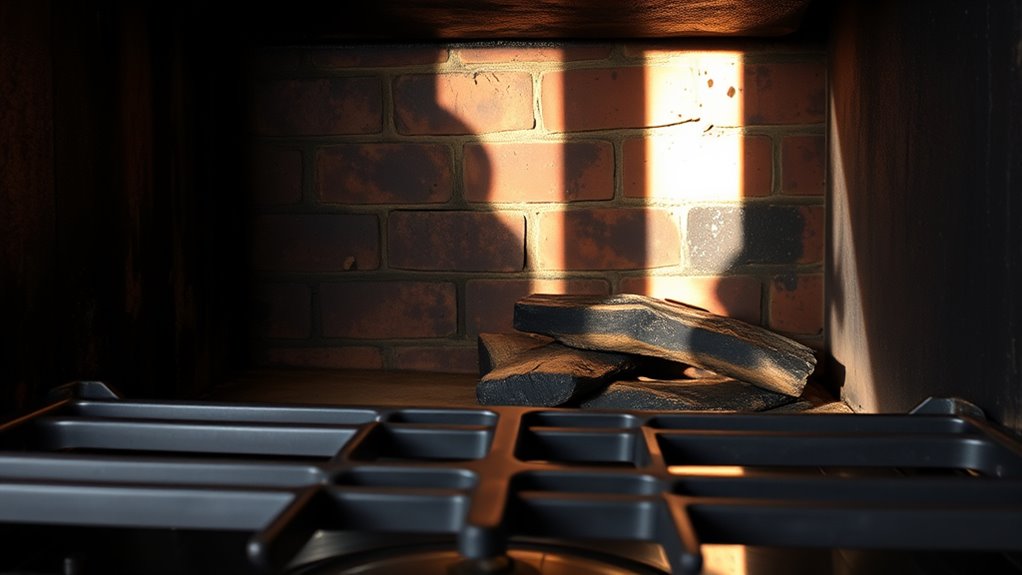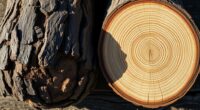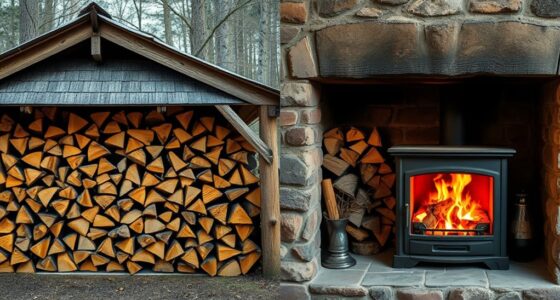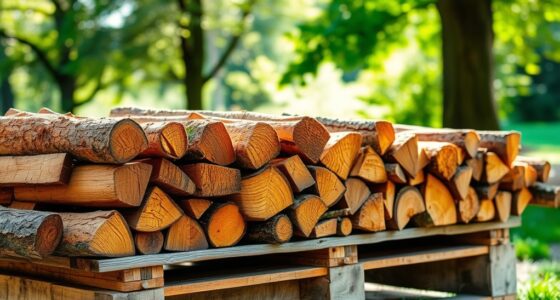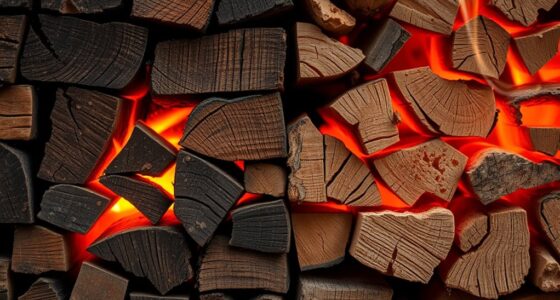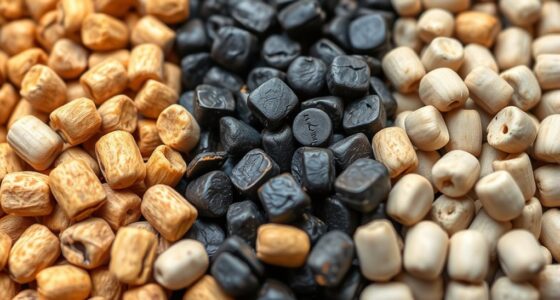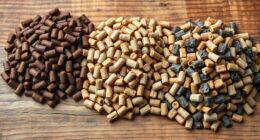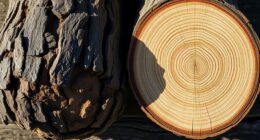Choosing the right fuel is key to reducing creosote buildup in your chimney. When you burn moisture-rich or low-quality fuels, incomplete combustion occurs, creating more unburned particles, tar, and soot that settle on chimney walls. Hardwoods that are properly seasoned burn hotter and cleaner, producing less creosote. By selecting high-quality, dry fuel and ensuring proper burning practices, you can lower fire risks and improve efficiency. Keep exploring to learn more about how your fuel choices impact chimney safety.
Key Takeaways
- High-moisture fuels produce more smoke and unburned particles, leading to increased creosote deposits.
- Well-seasoned, dry hardwood burns cleaner, reducing creosote buildup compared to green or softwood fuels.
- Incomplete combustion from poor fuel quality or airflow causes thicker, stickier creosote residues.
- Complete, efficient burning minimizes unburned hydrocarbons and tar, decreasing creosote formation.
- Proper fuel choice and burning practices enhance safety by limiting chimney creosote accumulation.
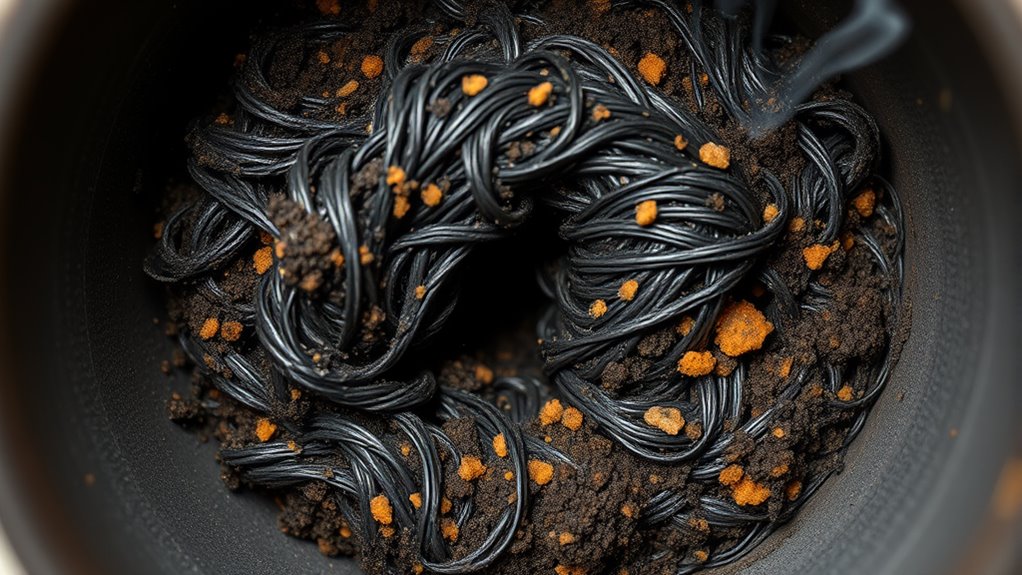
Have you ever wondered what gives creosote its unique properties and why it’s been used for centuries? The answer lies in its formation, which directly relates to how your choice of fuel affects the buildup inside your chimney or stove. When you burn wood, coal, or other combustible materials, the composition of that fuel—their fuel composition—plays a critical role in whether creosote forms and how much accumulates over time. Fuels with high moisture content or low calorific value tend to produce more smoke and unburned particles, which settle as creosote on chimney walls. Conversely, fuels with ideal fuel composition burn cleaner, releasing fewer byproducts that lead to buildup.
Your goal should be to maximize combustion efficiency, which means getting more energy out of your fuel with less waste. When your stove or fireplace operates at high combustion efficiency, it burns hot and completely, reducing the amount of unburned hydrocarbons that can condense on cooler surfaces. Incomplete combustion, often caused by poor fuel quality or improper airflow, results in a higher production of creosote. That’s because incomplete burning leaves behind tarry residues and unburned particles that settle as thick, sticky deposits. These deposits can not only clog your chimney but also pose fire hazards, making understanding the link between fuel composition and combustion efficiency essential for safe and effective heating.
Maximize efficiency by burning well-dried fuel to reduce creosote and fire hazards.
Choosing the right type of fuel is a key factor here. Hardwood, for example, has a better fuel composition for producing a cleaner burn compared to softer woods or green, unseasoned wood. Properly seasoned wood with low moisture content enhances combustion efficiency, leading to less creosote buildup. When you load your stove with well-dried wood, you help ensure the fuel burns hotter and more completely, reducing the chances of creosote formation. Additionally, maintaining proper airflow allows for ideal combustion, further improving efficiency and minimizing soot and creosote deposits.
In essence, understanding the science behind fuel composition and combustion efficiency lets you control creosote buildup. It’s not just about choosing the right fuel but also about burning it efficiently. When you do this, you reduce the risk of chimney fires, improve your heating system’s performance, and extend its lifespan. By paying attention to the quality of your fuel and how effectively it burns, you’re actively managing the chemistry of combustion, which ultimately keeps your chimney cleaner and safer. Moreover, adopting practices that promote complete combustion can help you become more environmentally conscious by reducing emissions and waste.
Frequently Asked Questions
How Can I Prevent Creosote Buildup in My Chimney?
To prevent creosote buildup, you should burn well-seasoned, dry wood, as wet wood produces more creosote. Regularly inspect and clean your chimney, and consider installing spark guards to contain embers. Also, guarantee proper chimney insulation to maintain a consistent temperature, which reduces creosote formation. These steps help your chimney stay cleaner and safer, minimizing fire risks caused by creosote buildup.
What Are the Health Risks of Creosote Accumulation?
If creosote builds up in your chimney, it could cause a chimney fire, which is more destructive than a wildfire. Breathing in creosote fumes can severely harm your respiratory health, leading to chronic coughs, asthma, or even lung damage. Ignoring creosote buildup isn’t just risky; it’s like inviting disaster into your home, putting you and your loved ones in serious danger of fire and health issues.
Does Wood Type Influence Creosote Formation?
Yes, wood type influences creosote formation. Denser woods with high moisture content tend to produce more creosote because they burn less efficiently, leaving behind oily residues. When you choose hardwoods with low moisture content, you reduce creosote buildup, making your fires safer and cleaner. Always guarantee your wood is properly seasoned; this minimizes moisture and helps prevent excessive creosote accumulation in your chimney.
How Often Should I Clean My Chimney to Prevent Creosote?
You should clean your chimney at least once a year to prevent creosote buildup. Regular chimney inspections help identify any dangerous creosote accumulation early. If you use your fireplace frequently or burn hardwood, consider scheduling cleanings more often, maybe twice a year. Maintaining a consistent cleaning schedule ensures safe operation, reduces fire risks, and keeps your chimney in good condition. Don’t skip inspections—they’re key to catching issues before they become serious.
Are There Environmentally Friendly Alternatives to Traditional Creosote?
Imagine a crackling fire that warms your home without leaving a dark, sticky residue. Eco-friendly treatments and biodegradable alternatives help reduce creosote buildup, making chimney cleaning safer for the environment. These options break down naturally, minimizing harmful emissions and preserving air quality. By choosing environmentally friendly fuels and treatments, you support a cleaner planet while enjoying the cozy glow of your fireplace, knowing you’re making a responsible, sustainable choice.
Conclusion
Understanding how your fuel choice impacts creosote buildup is vital. Did you know that using the right type of wood can reduce creosote formation by up to 50%? This not only keeps your chimney cleaner but also minimizes fire risks and improves efficiency. By choosing well-seasoned, dry wood and avoiding softwoods, you can enjoy a safer, more efficient fire. Small changes in your fuel choices make a big difference in preventing dangerous creosote buildup.

